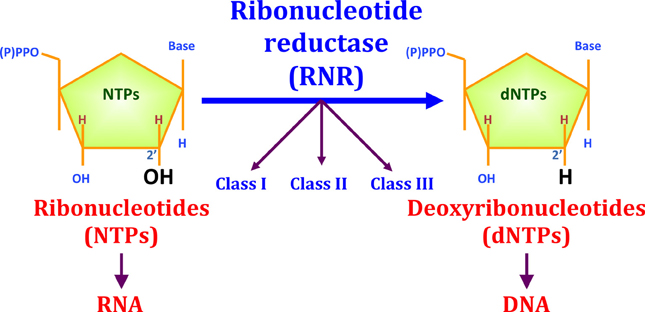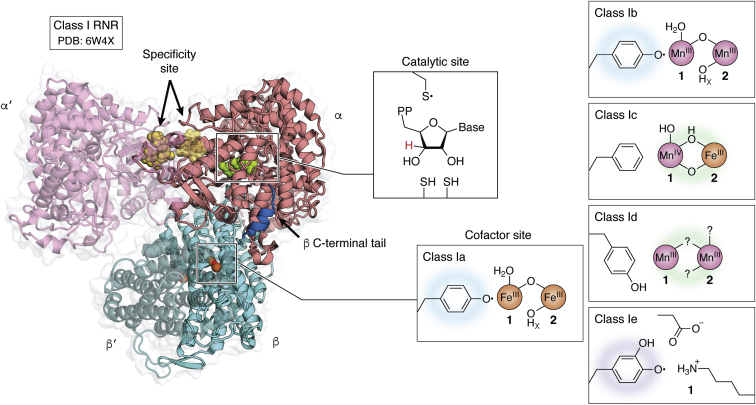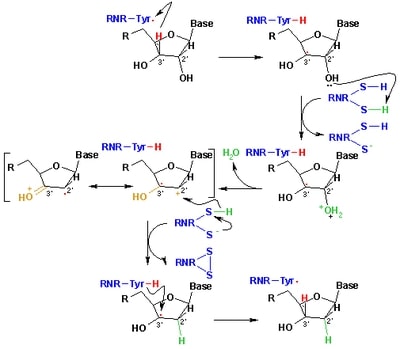User:Max Hideki Oliveira Homma/Sandbox 1
From Proteopedia
(Difference between revisions)
| Line 26: | Line 26: | ||
The small R2 structure, also known as beta2-homodimer, encoded by the Nrdb genes, contains a binding site for two iron ions in each polypeptide chain, where the interaction with the metallic cofactor occurs. Metal ion transitions are necessary cofactors to reduce nucleotides, as they generate an oxidant to an active cysteine site (Cys), producing a thiyl radical that is necessary for the initiation of catalysis in all RNRs. | The small R2 structure, also known as beta2-homodimer, encoded by the Nrdb genes, contains a binding site for two iron ions in each polypeptide chain, where the interaction with the metallic cofactor occurs. Metal ion transitions are necessary cofactors to reduce nucleotides, as they generate an oxidant to an active cysteine site (Cys), producing a thiyl radical that is necessary for the initiation of catalysis in all RNRs. | ||
| - | == | + | == R1 subunit and active site == |
| + | In Ia RNRs the catalytic site is located in the R1 subunit. This subunit is composed of two identical polypeptide chains, thus forming a homodimer. These chains are formed by both alpha helices and beta sheets, and close to the active site an alpha/beta barrel is formed, which is highly conserved among RNR classes. In addition to the active site, two important allosteric sites are also located in the R1 subunit: the specificity site (S site) and the activity site (A site). | ||
| + | |||
| + | The catalysis mechanism performed at the RNR active site is represented in the image. | ||
| + | [[Image:RNR3.jpg]] | ||
| + | |||
| + | Initially, the hydrogen bonded to the 3' carbon of the ribose ribonucleotide is transferred to the thiyl radical of Cys439. As a result, the 2'OH radical becomes more accessible for acid hydrolysis and its protonation is catalyzed by Cys225 and Glu441, resulting in the exit of a molecule from the substrate. After that, a proton is transferred from Cys462 to Cys225 which then transfers a hydrogen to the 2' carbon. Then, the transfer of a hydrogen to the 2' carbon of the substrate occurs concomitantly with the formation of a disulfide bridge between the Cys225 and Cys462 of the RNR. Finally, till radical regeneration occurs with the transfer of a hydrogen from Cys439 to the 3' carbon of the substrate, leading to the release of a deoxyribonucleotide. At the end of the catalysis, the disulfide bridge between Cys225 and Cys462 must still be reduced. The electron used in this reduction comes from a redox chain whose initial donor is NADPH. Numerous components participate in this redox chain, including Cys 754 and Cys759 from R1 itself. The reduction of the disulfide bridge between Cys225 and Cys462 would be very difficult to occur if there was a radical very close to the disulfide bridge, since the tendency would be for this radical to be reduced instead of the disulfide bridge. This is a likely explanation for the existence of a second subunit in the RNR, as the R2 subunit harbors a tyrosyl radical that is difficult to reduce. | ||
| + | |||
| + | == R2 subunit and cofactor == | ||
| + | |||
| + | |||
| + | |||
This is a sample scene created with SAT to <scene name="/12/3456/Sample/1">color</scene> by Group, and another to make <scene name="/12/3456/Sample/2">a transparent representation</scene> of the protein. You can make your own scenes on SAT starting from scratch or loading and editing one of these sample scenes. | This is a sample scene created with SAT to <scene name="/12/3456/Sample/1">color</scene> by Group, and another to make <scene name="/12/3456/Sample/2">a transparent representation</scene> of the protein. You can make your own scenes on SAT starting from scratch or loading and editing one of these sample scenes. | ||
Revision as of 14:39, 13 June 2022
</math>==Your Heading Here (maybe something like 'Structure')==
| |||||||||||
References
- ↑ Hanson, R. M., Prilusky, J., Renjian, Z., Nakane, T. and Sussman, J. L. (2013), JSmol and the Next-Generation Web-Based Representation of 3D Molecular Structure as Applied to Proteopedia. Isr. J. Chem., 53:207-216. doi:http://dx.doi.org/10.1002/ijch.201300024
- ↑ Herraez A. Biomolecules in the computer: Jmol to the rescue. Biochem Mol Biol Educ. 2006 Jul;34(4):255-61. doi: 10.1002/bmb.2006.494034042644. PMID:21638687 doi:10.1002/bmb.2006.494034042644



